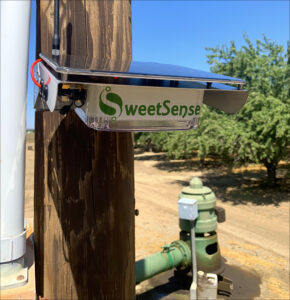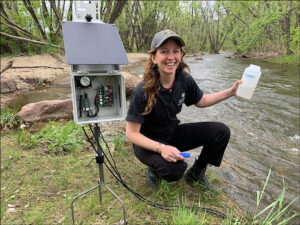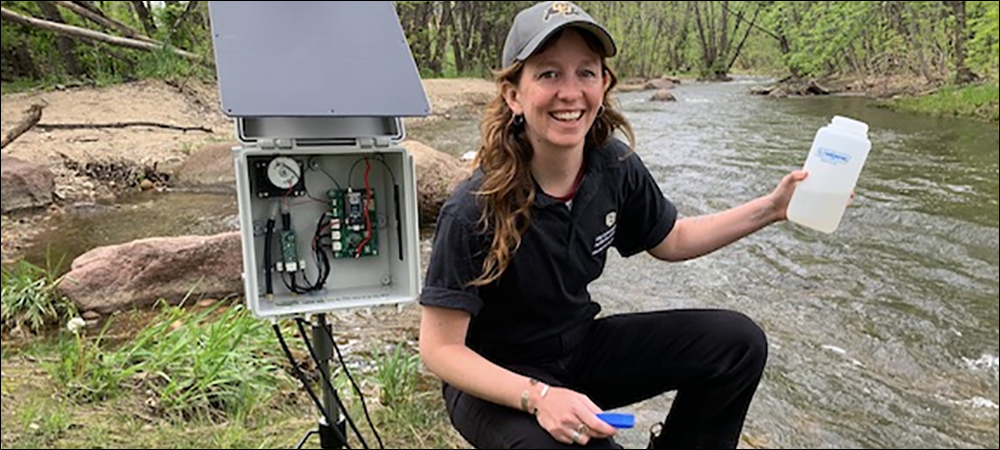Farmers throughout the Western United States are operating in a multi-year mega-drought that has impacted water availability and usage for crops and livestock. Farms typically lack data regarding how much water is being pumped into their fields or directed to animal troughs, or when this occurs. That water consumption is not only costly for farmers but has a large impact on drought-stricken regions. For that reason, two technology companies are providing an Internet of Things (IoT)-based service in partnership with more than a dozen farmers, to monitor the pumping of water in order to manage usage across dry regions and reduce costs.
SweetSense‘s Resilience IoT technologies are already in use in Africa, and are now being deployed in the United States, most recently leveraging LoRa-enabled satellite connectivity from Swarm. The Swarm network is intended to enable low-cost data access anywhere around the world. Its network consists of two-way connectivity for IoT devices via satellites. Based in Boulder, Colo., SweetSense has deployed approximately a dozen of the LoRa-based water-management sensors, using connectivity from Swarm, at farm sites in California’s Solano County, with more slated to go live in August 2021.

That follows deployments of earlier versions of sensors with other connectivity technologies in Africa. SweetSense’s solution was first devised around 2012 at Oregon’s Portland State University by associate professor Evan Thomas, now the company’s CEO. Thomas transferred to the University of Colorado (CU) Boulder 10 years ago, after which SweetSense was spun out to solve an infrastructure-monitoring problem in East Africa, according to Matthew Tolbirt, the company’s chief business officer.
At the time, nonprofit organizations were donating money to dig wells in remote rural and poverty-stricken African communities. However, the company found that contracts for maintenance often were not fulfilled. That meant well pumps might break and remain unrepaired, leaving a community once again without clean water, often for months at a time. SweetSense was intended to solve that problem by providing real-time well monitoring and transmitting water levels wirelessly to the company’s server. The system was deployed at 700 sites, serving a population of four million people throughout Kenya and Ethiopia. Many of the projects are funded by USAID or The World Bank.
SweetSense’s solution has traditionally leveraged cellular or Iridium satellite-based data. However, cellular systems are limited to places where there is a neighboring cell tower, and traditional satellite technology could be prohibitively expensive. Approximately four years ago, SweetSense began working with Swarm to enable a low-cost IoT solution leveraging Swarm’s LoRa-based satellites and its Tile modems where SweetSense’s systems are in use. SweetSense has been expanding the data it collects and manages to combine sensor readings with, for instance, weather statistics and NASA’s geospatial data, enabling it to forecast droughts in areas in which sensors are in use. Most existing systems, however, still utilize either cellular or Iridium satellite connectivity.
Recently, Tolbirt says, the Gordon and Betty Moore Foundation approached the research team at CU Boulder’s Mortenson Center in Global Engineering, who in turn, enlisted the help of SweetSense. “Frankly, some of the communities in the western states of the U.S. are facing some of the same issues,” he states, so the foundation sought to address them using use SweetSense’s technology and the Mortenson Center’s know-how. “We’ve been in a mega-drought in the Western United States since about 2000.” Farmers have little data about their own water consumption, even as pressure builds to better manage the dwindling supply.
 Across the U.S. Southwest, Tolbirt adds, most water is being used for farming and agriculture. In California, farmers have not been required to measure the usage of groundwater on their property, but that will change. The state’s legislation, known as the Sustainable Groundwater Management Act (SGMA), will mandate farmer-led management of water usage to support the supply in groundwater basins. To accomplish that goal, he says, farmers will need to use some form of metering on water pumps.
Across the U.S. Southwest, Tolbirt adds, most water is being used for farming and agriculture. In California, farmers have not been required to measure the usage of groundwater on their property, but that will change. The state’s legislation, known as the Sustainable Groundwater Management Act (SGMA), will mandate farmer-led management of water usage to support the supply in groundwater basins. To accomplish that goal, he says, farmers will need to use some form of metering on water pumps.
With funding from the Moore Foundation and the Mortenson Center, SweetSense is deploying the Swarm-enabled wireless system of water-use sensors for a dozen or so volunteering farmers, so that it can better understand the impact of groundwater pumping on the overall water supply and develop better models for predicting future droughts. SweetSense shares the data with the farmers and also provides an anonymized version of the information to CU Boulder’s Mortenson Center in Global Engineering.
A dozen sensors have been deployed in Solano County, while 50 more are expected to be taken live within the state in August, as well as in Colorado and New Mexico. “These are farmers who understand the fact that things are changing climate-wise,” Tolbirt states. “We were brought over to look at forecasting droughts.” He says farmers wanted to better understand their usage, not only to meet future mandates and recognize how they might need to change consumption to ensure their water doesn’t run out, but also to save money.
SweetSense monitors the power consumed by water pumps to manage water flow, and it can thus provide variable-use systems by which the flow can be shut down during peak-use and high-cost times, then resume operation during lower-cost times, such as evenings. The firm has built Swarm’s satellite technology into its own sensor devices, which transmit data to Swarm Tile modems. The modems, in turn, forward the data via eight-inch antennas to the Low Earth Orbit (LEO) satellites, using Swarm’s proprietary protocol and cloud-based software, according to Sara Spangelo, Swarm’s cofounder and CEO. The SweetSense software can provide analytics regarding the sensor readings and link that information with other data, such as weather.
 “Farmers are some of the most entrepreneurial people you’ll meet,” Tolbirt says. “They try to be stewards of the land. We’ve run into a gamut of farmers, but the most successful are the ones ahead of the curve—they see what’s coming.” He expains that farmers simply lacked access to this data before and are thus curious to learn such details. Researchers at UC Boulder can leverage the data for mapping out climate-related issues in the Western United States, as well as in developing countries, with a focus on Africa.
“Farmers are some of the most entrepreneurial people you’ll meet,” Tolbirt says. “They try to be stewards of the land. We’ve run into a gamut of farmers, but the most successful are the ones ahead of the curve—they see what’s coming.” He expains that farmers simply lacked access to this data before and are thus curious to learn such details. Researchers at UC Boulder can leverage the data for mapping out climate-related issues in the Western United States, as well as in developing countries, with a focus on Africa.
For SweetSense, Tolbirt reports, the goal is much larger than new technology. “We’re not designed just to sell another widget—we care about the science,” he states. “We’re looking at the whole picture, the whole water system and environment, to help farmers be more resilient.” Many farmers have already changed some of their watering practices to reduce consumption, such as by deploying drip irrigation. SweetSense’s variable-power solution could enable them to better ensure the 200-horsepower electric pumps that operate these systems run at optimal times.
For that purpose, SweetSense provides a CT clamp in its seventh-generation sensor device, which can be fitted around the power lines that feed the pumps and then be remotely activated by SweetSense, based on energy demand and cost peaks. “We’re providing the ability to save money,” Tolbirt explains, “by turning pumps on and off when energy is in high demand,” and thus more expensive.

Matthew Tolbirt
In Africa, Tolbirt reports, the technology is being used to understand infrastructure health, whereas the California system is about managing consumption. “California is a conservation story,” he notes, “of ‘How can we conserve water, conserve energy and change consumption patterns to benefit farmers businesses?'” The system can operate with a variety of sensors that track such conditions as soil moisture, precipitation and temperature. A solar panel powers the sensors, while the CT clamp is powered by the water pump.
The Swarm-based SweetSense technology has been in use at six pumps in Solano County to date, Tolbirt says, and the system is working well and yielding reliable data. The farms being covered include fields of tomatoes and almonds. These farmers were made aware of SweetSense’s work through a partnership with The Freshwater Trust, a non-profit that protects and restores freshwater ecosystems The trust also works collaboratively with agriculture to balance the needs of a productive farm and the shared water resources. Initially, SweetSense is providing farmers with a Microsoft Excel spreadsheet listing the energy and pump data, and the rest of the information is delivered to researchers CU Boulder for use in drought forecasting and management.

Sara Spangelo
U.S. farmers will use the system for at least two years, Tolbirt says. Ultimately, by employing Swarm’s LoRa technology, SweetSense has been able to bring down the cost of wireless data transmission, he reports, since Iridium’s satellite use tends to be five or six times more expensive than Swarm, the company estimates. Currently, Swarm has 120 satellites orbiting Earth, with an additional 30 expected to be in space by early next year.
“We’re really excited about SweetSense,” Spangelo says. “This is why we started Swarm, to support programs like this.” The Swarm-enabled sensors and gateways are slated to be shipped to Somalia, Nigeria and Mozambique in August, pending regulatory approvals. Those funding the efforts include Catholic Relief Services, Save the Children and the Green Climate Fund.


